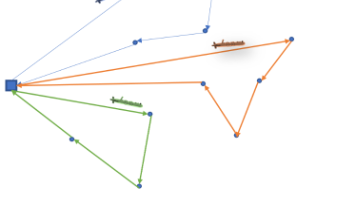人工智能革命下的宇宙探索:中国与国际在天文学领域的AI技术竞合
人工智能正在深刻变革天文学研究。面对FAST、LSST等大型巡天项目产生的海量数据(日均20TB),传统分析方法已难以应对。AI技术在星系分类、系外行星探测、光谱分析等领域展现出强大能力:1)基于ResNet的CNN模型实现高效星系分类;2)深度学习自动解析天体光谱物理信息;3)中国研究团队利用AI处理FAST数据发现新脉冲星候选体。国际上天文学与AI的跨学科融合已成趋势,各国正加强合作攻克宇宙探
人工智能革命下的宇宙探索:中国与国际在天文学领域的AI技术竞合
引言:当AI遇见星空
在科技迅猛发展的当下,天文学正经历着一场前所未有的数据革命,其规模和速度都超乎想象。大型巡天项目如LSST(大型综合巡天望远镜),犹如宇宙的"超级摄影师",每晚都会捕捉到海量的天文信息,产生高达20TB的数据。这些数据就像宇宙的密码,蕴含着星系的形成与演化、恒星的生命周期、暗物质和暗能量的奥秘等无数未知的答案。与此同时,被誉为"中国天眼"的FAST射电望远镜,以其卓越的灵敏度和观测能力,每年生成数PB的观测数据,不断拓展着人类对宇宙的认知边界。然而,面对如此海量且复杂的数据,传统的天文学分析方法逐渐显得力不从心。以往,天文学家需要花费大量的时间和精力,对观测数据进行手动筛选、分类和分析,不仅效率低下,而且容易遗漏一些重要的信息。此外,随着观测技术的不断进步,数据的维度和复杂性也在不断增加,传统方法已经难以应对这些挑战。在这样的背景下,人工智能技术应运而生,并迅速成为破解宇宙奥秘的关键工具。人工智能具有强大的数据处理和分析能力,能够快速处理海量的天文数据,自动识别和提取其中的特征信息,发现隐藏在数据背后的规律和模式。它就像是一位超级"数据侦探",能够帮助天文学家更高效地探索宇宙的未知领域。
本文将深入探讨人工智能在天文学领域的广泛应用。在星系分类方面,人工智能算法可以通过学习大量已知星系的特征,对新的星系观测数据进行自动分类,大大提高了分类的准确性和效率。在系外行星探测中,人工智能能够分析恒星的光变曲线,识别出可能存在的行星信号,为寻找地球以外的宜居星球提供了有力支持。此外,人工智能还在宇宙学模拟、引力波探测等领域发挥着重要作用。在中国,人工智能在天文学领域的发展取得了令人瞩目的成就。中国的科研团队积极推动人工智能技术与天文观测设备的深度融合,不断提升数据处理和分析的能力。例如,利用人工智能算法对FAST的观测数据进行处理,发现了一批新的脉冲星候选体,为脉冲星的研究提供了重要线索。同时,中国还加强了在国际天文学领域的合作与交流,积极参与国际大型天文项目,与世界各国的科学家共同探索宇宙的奥秘。从国际前沿趋势来看,人工智能与天文学的融合将成为未来天文学发展的重要方向。越来越多的国家和科研机构加大了在这方面的投入,不断推动人工智能技术的创新和应用。国际上正在开展一系列跨学科的研究项目,旨在整合天文学、计算机科学、数学等多学科的力量,共同攻克天文学领域面临的重大难题。可以预见,在人工智能的助力下,天文学将迎来更加辉煌的发展时期,人类对宇宙的认识也将不断深入和拓展。

一、人工智能在天文学中的核心应用领域
1.1 天体检测与分类
卷积神经网络(CNN)在天体检测与分类中表现出卓越性能,以下是一个基于ResNet的星系分类实现。这段代码展示了如何使用迁移学习技术,将在大规模图像数据集上预训练的ResNet模型适配到天文图像分类任务中。通过替换全连接层并冻结部分底层参数,我们可以在相对较小的天文数据集上实现高效训练。
import torch
import torch.nn as nn
import torchvision.models as models
from torch.utils.data import DataLoader
import astronet
class GalaxyClassifier(nn.Module):
def __init__(self, num_classes=3):
super(GalaxyClassifier, self).__init__()
self.base_model = models.resnet50(pretrained=True)
in_features = self.base_model.fc.in_features
self.base_model.fc = nn.Linear(in_features, 512)
self.classifier = nn.Sequential(
nn.ReLU(),
nn.Dropout(0.3),
nn.Linear(512, num_classes)
)
def forward(self, x):
features = self.base_model(x)
return self.classifier(features)
# 数据预处理
def create_galaxy_dataloader(data_dir, batch_size=32):
transform = transforms.Compose([
transforms.RandomResizedCrop(224),
transforms.RandomHorizontalFlip(),
transforms.ColorJitter(0.1, 0.1, 0.1),
transforms.ToTensor(),
transforms.Normalize([0.485, 0.456, 0.406], [0.229, 0.224, 0.225])
])
dataset = datasets.ImageFolder(data_dir, transform=transform)
return DataLoader(dataset, batch_size=batch_size, shuffle=True)
# 训练循环
def train_galaxy_classifier(model, dataloader, num_epochs=50):
criterion = nn.CrossEntropyLoss()
optimizer = torch.optim.Adam(model.parameters(), lr=0.001)
scheduler = torch.optim.lr_scheduler.StepLR(optimizer, step_size=10, gamma=0.1)
for epoch in range(num_epochs):
for images, labels in dataloader:
outputs = model(images)
loss = criterion(outputs, labels)
optimizer.zero_grad()
loss.backward()
optimizer.step()
scheduler.step()
print(f'Epoch [{epoch+1}/{num_epochs}], Loss: {loss.item():.4f}')
1.2 光谱分析自动化
天体光谱包含丰富的物理信息,深度学习可高效提取这些信息。下面的代码实现了一个自动编码器结合分类器的网络结构,能够同时进行光谱重建和恒星分类。自动编码器部分学习光谱的低维表示,而分类器则利用这些表示进行恒星类型分类。
import numpy as np
import tensorflow as tf
from astropy.io import fits
class SpectralAnalyzer(tf.keras.Model):
def __init__(self, input_dim=4000, latent_dim=128):
super(SpectralAnalyzer, self).__init__()
self.encoder = tf.keras.Sequential([
tf.keras.layers.Dense(1024, activation='relu'),
tf.keras.layers.Dropout(0.2),
tf.keras.layers.Dense(512, activation='relu'),
tf.keras.layers.Dense(latent_dim)
])
self.decoder = tf.keras.Sequential([
tf.keras.layers.Dense(512, activation='relu'),
tf.keras.layers.Dropout(0.2),
tf.keras.layers.Dense(1024, activation='relu'),
tf.keras.layers.Dense(input_dim, activation='linear')
])
self.classifier = tf.keras.Sequential([
tf.keras.layers.Dense(64, activation='relu'),
tf.keras.layers.Dense(32, activation='relu'),
tf.keras.layers.Dense(5, activation='softmax') # 5类恒星分类
])
def call(self, x):
encoded = self.encoder(x)
decoded = self.decoder(encoded)
classification = self.classifier(encoded)
return decoded, classification
# 处理FITS光谱文件
def process_spectra_fits(file_path):
with fits.open(file_path) as hdul:
flux = hdul[0].data
header = hdul[0].header
# 归一化处理
flux_normalized = (flux - np.min(flux)) / (np.max(flux) - np.min(flux))
return flux_normalized, header
# 创建光谱数据集
def create_spectral_dataset(fits_files, labels):
spectra = []
processed_labels = []
for file_path, label in zip(fits_files, labels):
flux, header = process_spectra_fits(file_path)
spectra.append(flux)
processed_labels.append(label)
return np.array(spectra), np.array(processed_labels)
1.3 时域天文学与异常检测
时域天文学产生大量时间序列数据,需要异常检测算法发现新现象。以下代码展示了如何结合传统机器学习方法和图像转换技术来处理天文时间序列数据。Isolation Forest用于异常检测,而Gramian Angular Field则将时间序列转换为图像,便于使用计算机视觉方法进行分类。
import pandas as pd
from sklearn.ensemble import IsolationForest
from pyts.classification import KNeighborsClassifier
from pyts.transformation import GramianAngularField
class AstronomicalTimeSeriesAnalyzer:
def __init__(self, contamination=0.01):
self.anomaly_detector = IsolationForest(contamination=contamination)
self.classifier = KNeighborsClassifier()
self.gaf = GramianAngularField()
def extract_features(self, time_series):
# 提取时域特征
features = {
'mean': np.mean(time_series),
'std': np.std(time_series),
'skewness': pd.Series(time_series).skew(),
'kurtosis': pd.Series(time_series).kurtosis(),
'max_slope': np.max(np.diff(time_series))
}
# 转换为Gramian Angular Field图像
gaf_image = self.gaf.transform(time_series.reshape(1, -1))
return features, gaf_image
def detect_anomalies(self, time_series_data):
features = [self.extract_features(ts)[0] for ts in time_series_data]
feature_df = pd.DataFrame(features)
anomalies = self.anomaly_detector.fit_predict(feature_df)
return anomalies
def classify_variability(self, time_series_data, labels):
gaf_images = np.array([self.extract_features(ts)[1] for ts in time_series_data])
n_samples = gaf_images.shape[0]
gaf_images_flat = gaf_images.reshape(n_samples, -1)
self.classifier.fit(gaf_images_flat, labels)
return self.classifier
二、中国在天文AI领域的发展与成就
2.1 国家战略与重大项目
中国已将"人工智能+天文学"纳入国家科技创新规划,以下是中国主要天文AI项目:
| 项目名称 | 牵头机构 | 主要目标 | 技术特点 |
|---|---|---|---|
| China-VO | 国家天文台 | 构建虚拟天文台 | 分布式计算、数据挖掘 |
| FAST数据AI处理 | 中科院FAST重点实验室 | 脉冲星识别与信号处理 | 深度学习、信号处理 |
| LAMOST光谱分析 | 国家天文台 | 恒星参数测量 | 卷积神经网络、自动编码器 |
| 太极计划 | 中山大学 | 空间引力波数据处理 | 时间序列分析、模式识别 |
2.2 FAST射电望远镜的AI应用
500米口径球面射电望远镜(FAST)每天产生大量数据,AI技术至关重要。以下代码展示了FAST数据处理中的关键步骤,包括去色散处理、脉冲星候选体寻找以及基于CNN的脉冲星识别。这些算法帮助天文学家从海量数据中快速筛选出有价值的脉冲星信号。
import numpy as np
from scipy import signal
from astropy.io import fits
import pulsar_search
class FASTDataProcessor:
def __init__(self, sample_rate=1e6, min_dm=0, max_dm=100):
self.sample_rate = sample_rate
self.min_dm = min_dm
self.max_dm = max_dm
def dedisperse(self, data, dm):
"""去色散处理"""
frequencies = np.linspace(1400, 1500, data.shape[0])
delay = 4.15 * dm * (1/frequencies**2 - 1/1400**2)
delay_bins = (delay * self.sample_rate).astype(int)
dedispersed = np.zeros_like(data)
for i in range(data.shape[0]):
dedispersed[i] = np.roll(data[i], -delay_bins[i])
return dedispersed
def find_candidates(self, data, threshold=5.0):
"""寻找脉冲星候选体"""
# 使用匹配滤波技术
template = self.create_template()
correlated = signal.correlate(data, template, mode='same')
# 寻找峰值
peaks, properties = signal.find_peaks(correlated, height=threshold)
return peaks, correlated
def create_template(self, pulse_width=100):
"""创建脉冲模板"""
template = np.zeros(1000)
center = len(template) // 2
template[center-pulse_width//2:center+pulse_width//2] = 1
return template
def process_observation(self, fits_file):
"""处理观测数据"""
with fits.open(fits_file) as hdul:
data = hdul[0].data
candidates = []
for dm in np.linspace(self.min_dm, self.max_dm, 100):
dedispersed = self.dedisperse(data, dm)
integrated = np.sum(dedispersed, axis=0)
peaks, values = self.find_candidates(integrated)
for peak in peaks:
snr = values[peak] / np.std(values)
if snr > 6.0:
candidates.append({
'dm': dm,
'period': self.estimate_period(integrated),
'snr': snr,
'position': peak
})
return candidates
# 使用CNN进行脉冲星识别
class PulsarCNN(tf.keras.Model):
def __init__(self):
super(PulsarCNN, self).__init__()
self.conv1 = tf.keras.layers.Conv2D(32, (3, 3), activation='relu')
self.pool1 = tf.keras.layers.MaxPooling2D((2, 2))
self.conv2 = tf.keras.layers.Conv2D(64, (3, 3), activation='relu')
self.pool2 = tf.keras.layers.MaxPooling2D((2, 2))
self.flatten = tf.keras.layers.Flatten()
self.dense1 = tf.keras.layers.Dense(128, activation='relu')
self.dropout = tf.keras.layers.Dropout(0.3)
self.dense2 = tf.keras.layers.Dense(1, activation='sigmoid')
def call(self, x):
x = self.conv1(x)
x = self.pool1(x)
x = self.conv2(x)
x = self.pool2(x)
x = self.flatten(x)
x = self.dense1(x)
x = self.dropout(x)
return self.dense2(x)
2.3 LAMOST光谱巡天的AI创新
大天区面积多目标光纤光谱望远镜(LAMOST)已获取数千万条光谱。以下代码展示了LAMOST光谱数据的处理流程,包括光谱预处理、宇宙射线去除、恒星参数测量和光谱分类。这些算法实现了从原始光谱数据到物理参数的自动化提取。
import astropy
import specutils
from specutils import Spectrum1D
from astropy.nddata import StdDevUncertainty
class LAMOSTAnalyzer:
def __init__(self):
self.flux_normalizer = None
self.wavelength_calibrator = None
def load_spectrum(self, file_path):
"""加载LAMOST光谱数据"""
try:
with fits.open(file_path) as hdul:
flux = hdul[0].data
header = hdul[0].header
wavelength = self.get_wavelength_array(header)
uncertainty = StdDevUncertainty(np.sqrt(np.abs(flux)))
return Spectrum1D(flux=flux * u.erg / u.cm**2 / u.s / u.Angstrom,
spectral_axis=wavelength * u.Angstrom,
uncertainty=uncertainty)
except Exception as e:
print(f"Error loading spectrum: {e}")
return None
def get_wavelength_array(self, header):
"""从头文件中获取波长数组"""
crval1 = header['CRVAL1']
cdelt1 = header['CDELT1']
naxis1 = header['NAXIS1']
return crval1 + cdelt1 * np.arange(naxis1)
def preprocess_spectrum(self, spectrum):
"""光谱预处理"""
# 1. 去除宇宙射线
cleaned = self.remove_cosmic_rays(spectrum)
# 2. 流量归一化
normalized = self.normalize_flux(cleaned)
# 3. 波长校准
calibrated = self.calibrate_wavelength(normalized)
return calibrated
def remove_cosmic_rays(self, spectrum, threshold=5.0):
"""使用小波变换去除宇宙射线"""
coeffs = pywt.swt(spectrum.flux.value, 'db4', level=3)
# 阈值处理高频系数
coeffs_thresh = [coeffs[0]] + [
(pywt.threshold(c, threshold * np.std(c), 'soft') if i > 0 else c)
for i, c in enumerate(coeffs[1:])
]
reconstructed = pywt.iswt(coeffs_thresh, 'db4')
return Spectrum1D(flux=reconstructed * spectrum.flux.unit,
spectral_axis=spectrum.spectral_axis)
def measure_stellar_parameters(self, spectrum):
"""测量恒星参数"""
# 使用神经网络估计有效温度、表面重力、金属丰度
features = self.extract_features(spectrum)
model = self.load_parameter_estimation_model()
parameters = model.predict(features.reshape(1, -1))
return {
'teff': parameters[0][0], # 有效温度
'logg': parameters[0][1], # 表面重力
'feh': parameters[0][2] # 金属丰度
}
def classify_spectral_type(self, spectrum):
"""光谱分类"""
# 使用卷积神经网络进行光谱分类
spectral_image = self.spectrum_to_image(spectrum)
model = self.load_classification_model()
probabilities = model.predict(spectral_image)
classes = ['O', 'B', 'A', 'F', 'G', 'K', 'M']
return classes[np.argmax(probabilities)], probabilities
2.4 中国虚拟天文台(China-VO)的AI平台
China-VO整合了多种AI工具和服务。以下代码展示了China-VO平台的客户端实现,包括数据查询、交叉证认、光变曲线获取和分析等功能。这些服务为天文学家提供了便捷的数据访问和分析工具。
from astroquery.virtual_observatory import VirtualObservatory
from astroML.datasets import fetch_sdss_spectrum
class ChinaVOClient:
def __init__(self, api_key=None):
self.base_url = "http://www.china-vo.org/api/v2"
self.session = requests.Session()
if api_key:
self.session.headers.update({'Authorization': f'Bearer {api_key}'})
def query_objects(self, ra, dec, radius, catalog='sdss'):
"""查询天体对象"""
params = {
'ra': ra,
'dec': dec,
'radius': radius,
'catalog': catalog
}
response = self.session.get(f"{self.base_url}/query", params=params)
return response.json()
def cross_match(self, catalog1, catalog2, max_distance=1.0):
"""交叉证认"""
data = {
'catalog1': catalog1,
'catalog2': catalog2,
'max_distance': max_distance
}
response = self.session.post(f"{self.base_url}/crossmatch", json=data)
return response.json()
def get_lightcurve(self, object_id, survey='ztf'):
"""获取光变曲线"""
params = {'survey': survey}
response = self.session.get(f"{self.base_url}/lightcurve/{object_id}", params=params)
return pd.DataFrame(response.json())
def analyze_lightcurve(self, object_id):
"""分析光变曲线"""
lightcurve = self.get_lightcurve(object_id)
# 提取特征
features = self.extract_lightcurve_features(lightcurve)
# 使用预训练模型分类
model = self.load_variable_star_model()
prediction = model.predict(features.reshape(1, -1))
return self.get_class_name(prediction[0])
def extract_lightcurve_features(self, lightcurve):
"""提取光变曲线特征"""
magnitudes = lightcurve['mag'].values
times = lightcurve['mjd'].values
features = {
'mean_mag': np.mean(magnitudes),
'std_mag': np.std(magnitudes),
'amplitude': np.max(magnitudes) - np.min(magnitudes),
'period': self.find_period(times, magnitudes),
'skewness': stats.skew(magnitudes),
'kurtosis': stats.kurtosis(magnitudes)
}
return np.array(list(features.values()))
三、国际天文AI研究前沿与趋势
3.1 大型巡天项目的AI应用
国际上的大型巡天项目广泛采用AI技术。以下代码展示了LSST数据处理中的AI应用,包括警报流处理、暂现源检测和光变曲线分类。这些算法需要处理LSST产生的海量实时数据,对计算效率和准确性都有极高要求。
import lsst.analysis as analysis
from rubin_sim import maf
class LSSTAIProcessor:
def __init__(self, data_release='dr8'):
self.data_release = data_release
self.metrics = {}
def process_alert_stream(self, alert_data):
"""处理LSST警报流"""
# 实时分类和优先级排序
classifications = self.classify_alerts(alert_data)
prioritized = self.prioritize_alerts(classifications)
return prioritized
def classify_alerts(self, alerts):
"""分类警报"""
features = self.extract_alert_features(alerts)
# 使用集成学习进行分类
classifier = self.load_alert_classifier()
predictions = classifier.predict_proba(features)
results = []
for i, alert in enumerate(alerts):
results.append({
'alert_id': alert['id'],
'classification': predictions[i],
'is_interesting': np.max(predictions[i]) > 0.7
})
return results
def prioritize_alerts(self, classified_alerts):
"""警报优先级排序"""
# 基于科学价值和紧迫性排序
prioritized = sorted(classified_alerts,
key=lambda x: (x['is_interesting'], np.max(x['classification'])),
reverse=True)
return prioritized
def detect_transients(self, image_data):
"""检测暂现源"""
# 使用卷积神经网络
model = self.load_transient_detection_model()
# 图像差分处理
difference_image = self.subtract_reference(image_data)
# 检测候选体
candidates = model.detect_candidates(difference_image)
return self.filter_candidates(candidates)
def lightcurve_classification(self, lightcurves):
"""光变曲线分类"""
# 使用时间序列分类算法
features = [self.extract_lightcurve_features(lc) for lc in lightcurves]
classifier = self.load_lightcurve_classifier()
predictions = classifier.predict(features)
return predictions
# 使用Google的TensorFlow处理天文数据
class TFAstroModel(tf.keras.Model):
def __init__(self, num_classes=10):
super(TFAstroModel, self).__init__()
self.data_augmentation = tf.keras.Sequential([
tf.keras.layers.RandomFlip("horizontal_and_vertical"),
tf.keras.layers.RandomRotation(0.2),
tf.keras.layers.RandomZoom(0.1),
])
self.base_model = tf.keras.applications.EfficientNetB0(
include_top=False, weights='imagenet')
self.base_model.trainable = False
self.global_average_layer = tf.keras.layers.GlobalAveragePooling2D()
self.dropout_layer = tf.keras.layers.Dropout(0.2)
self.prediction_layer = tf.keras.layers.Dense(num_classes, activation='softmax')
def call(self, inputs):
x = self.data_augmentation(inputs)
x = self.base_model(x, training=False)
x = self.global_average_layer(x)
x = self.dropout_layer(x)
return self.prediction_layer(x)
3.2 引力波天文学的AI突破
AI在引力波探测中发挥关键作用。以下代码展示了引力波数据处理中的AI应用,包括匹配滤波分析、深度学习检测和数据预处理。这些方法极大地提高了引力波信号的检测效率和准确性。
import gwpy
from gwpy.timeseries import TimeSeries
from pycbc import types, filter
class GravitationalWaveAI:
def __init__(self, sample_rate=4096):
self.sample_rate = sample_rate
self.waveform_templates = self.load_templates()
def load_templates(self):
"""加载波形模板"""
# 从模板库加载二元合并波形模板
templates = {}
for mass1 in np.arange(5, 50, 5):
for mass2 in np.arange(5, 50, 5):
if mass2 >= mass1:
template = self.generate_template(mass1, mass2)
templates[f'{mass1}_{mass2}'] = template
return templates
def generate_template(self, mass1, mass2, approximant='SEOBNRv4'):
"""生成波形模板"""
# 使用PyCBC生成模板
from pycbc.waveform import get_td_waveform
hp, hc = get_td_waveform(approximant=approximant,
mass1=mass1,
mass2=mass2,
delta_t=1.0/self.sample_rate,
f_lower=20)
return hp
def matched_filter_analysis(self, data, template):
"""匹配滤波分析"""
# 将数据转换为PyCBC类型
data_pycbc = types.TimeSeries(data, delta_t=1.0/self.sample_rate)
# 计算信噪比
snr = filter.matched_filter(template, data_pycbc)
return snr
def deep_learning_detection(self, strain_data):
"""深度学习检测引力波"""
# 使用卷积神经网络
model = self.load_gw_detection_model()
# 预处理数据
processed = self.preprocess_data(strain_data)
# 预测
prediction = model.predict(processed.reshape(1, -1, 1))
return prediction[0][0] > 0.5 # 二分类结果
def preprocess_data(self, data):
"""预处理应变数据"""
# 带通滤波
data_bandpass = self.bandpass_filter(data, low_freq=20, high_freq=500)
# 白化处理
data_whitened = self.whiten_data(data_bandpass)
# Q变换生成时频图
qtransform = self.q_transform(data_whitened)
return qtransform
def whiten_data(self, data):
"""数据白化处理"""
fft_data = np.fft.rfft(data)
power_spectrum = np.abs(fft_data) ** 2
# 计算平均功率谱
avg_power = np.mean(power_spectrum)
# 白化
whitened_fft = fft_data / np.sqrt(avg_power)
return np.fft.irfft(whitened_fft)
def q_transform(self, data):
"""Q变换生成时频表示"""
from scipy import signal
frequencies = np.logspace(np.log10(20), np.log10(500), 100)
q_range = np.linspace(4, 64, 50)
time_freq = np.zeros((len(frequencies), len(data)))
for i, f in enumerate(frequencies):
for j, q in enumerate(q_range):
# 生成Morlet小波
wavelet = signal.morlet2(len(data), [f, q])
coeffs = signal.convolve(data, wavelet, mode='same')
time_freq[i] += np.abs(coeffs) ** 2
return time_freq
3.3 多信使天文学的AI整合
AI整合多信使天文数据实现全新发现。以下代码展示了多信使天文学中的数据整合方法,包括坐标对齐、事件关联和贝叶斯概率分析。这些技术帮助天文学家将不同来源的天文数据整合起来,获得更全面的宇宙图景。
import healpy as hp
import gammapy
from gammapy.maps import WcsNDMap
class MultiMessengerIntegrator:
def __init__(self):
self.data_sources = {}
self.alignment_methods = {}
def register_data_source(self, name, data_loader, coordinate_system='icrs'):
"""注册数据源"""
self.data_sources[name] = {
'loader': data_loader,
'coord_system': coordinate_system
}
def align_coordinates(self, ra, dec, from_system, to_system='icrs'):
"""坐标对齐"""
if from_system == to_system:
return ra, dec
# 使用astropy进行坐标转换
from astropy.coordinates import SkyCoord
import astropy.units as u
coord = SkyCoord(ra=ra*u.degree, dec=dec*u.degree, frame=from_system)
coord_to = coord.transform_to(to_system)
return coord_to.ra.degree, coord_to.dec.degree
def correlate_events(self, events1, events2, max_distance=0.1):
"""关联事件"""
from astropy.coordinates import SkyCoord
from astropy import units as u
coords1 = SkyCoord(ra=events1['ra']*u.degree, dec=events1['dec']*u.degree)
coords2 = SkyCoord(ra=events2['ra']*u.degree, dec=events2['dec']*u.degree)
# 寻找匹配
idx, d2d, _ = coords1.match_to_catalog_sky(coords2)
matches = d2d < max_distance*u.degree
correlated = []
for i, match in enumerate(matches):
if match:
correlated.append({
'event1': events1.iloc[i],
'event2': events2.iloc[idx[i]],
'distance': d2d[i].degree
})
return correlated
def bayesian_probability(self, neutrino_event, gamma_events, gw_events):
"""贝叶斯概率分析"""
# 计算空间匹配概率
spatial_prob = self.calculate_spatial_probability(neutrino_event, gamma_events, gw_events)
# 计算时间匹配概率
temporal_prob = self.calculate_temporal_probability(neutrino_event, gamma_events, gw_events)
# 计算能量/强度概率
energy_prob = self.calculate_energy_probability(neutrino_event, gamma_events, gw_events)
# 组合概率
combined_prob = spatial_prob * temporal_prob * energy_prob
return combined_prob
def deep_multimodal_fusion(self, data_dict):
"""多模态深度学习融合"""
import torch
import torch.nn as nn
# 为每种数据类型创建编码器
encoders = nn.ModuleDict({
'optical': self.create_cnn_encoder(3), # RGB图像
'xray': self.create_cnn_encoder(1), # X射线图像
'spectral': self.create_spectral_encoder(),
'timedomain': self.create_time_series_encoder()
})
# 融合编码特征
fused_features = []
for data_type, data in data_dict.items():
if data_type in encoders and data is not None:
encoded = encoders[data_type](data)
fused_features.append(encoded)
# 连接所有特征
if fused_features:
combined = torch.cat(fused_features, dim=1)
# 分类器
classifier = nn.Sequential(
nn.Linear(combined.shape[1], 128),
nn.ReLU(),
nn.Dropout(0.3),
nn.Linear(128, 64),
nn.ReLU(),
nn.Linear(64, 1),
nn.Sigmoid()
)
return classifier(combined)
return None
四、天文AI中的挑战与创新解决方案
4.1 处理不平衡数据集
天文数据往往极度不平衡,需要特殊处理技术。以下代码展示了多种处理不平衡数据集的方法,包括过采样、欠采样和自定义采样策略。这些技术帮助提高模型对稀有天体类别的识别能力。
import imblearn
from imblearn.over_sampling import SMOTE
from imblearn.under_sampling import RandomUnderSampler
class AstronomicalDataBalancer:
def __init__(self, strategy='combined'):
self.strategy = strategy
self.samplers = {
'oversample': SMOTE(random_state=42),
'undersample': RandomUnderSampler(random_state=42),
'combined': self.combined_sampler
}
def combined_sampler(self, X, y):
"""组合过采样和欠采样"""
# 先过采样少数类
oversampler = SMOTE(random_state=42, sampling_strategy=0.1)
X_over, y_over = oversampler.fit_resample(X, y)
# 再欠采样多数类
undersampler = RandomUnderSampler(random_state=42, sampling_strategy=0.5)
X_balanced, y_balanced = undersampler.fit_resample(X_over, y_over)
return X_balanced, y_balanced
def balance_data(self, X, y):
"""平衡数据集"""
if self.strategy in self.samplers:
return self.samplers[self.strategy](X, y)
return X, y
def astronomical_specific_balancing(self, X, y, class_weights):
"""天文学特定的平衡方法"""
# 基于科学重要性加权的平衡
unique_classes = np.unique(y)
sampling_strategy = {}
for cls in unique_classes:
if cls in class_weights:
# 根据科学重要性调整样本数量
sampling_strategy[cls] = int(len(y) * class_weights[cls])
return self.custom_sampler(X, y, sampling_strategy)
def custom_sampler(self, X, y, sampling_strategy):
"""自定义采样器"""
from collections import Counter
from sklearn.utils import resample
class_counts = Counter(y)
resampled_X = []
resampled_y = []
for cls, target_count in sampling_strategy.items():
if cls in class_counts:
# 获取当前类的样本
class_mask = (y == cls)
X_class = X[class_mask]
y_class = y[class_mask]
# 重采样到目标数量
if len(X_class) > 0:
if len(X_class) < target_count:
# 过采样
X_resampled, y_resampled = resample(
X_class, y_class,
n_samples=target_count,
replace=True, random_state=42
)
else:
# 欠采样
X_resampled, y_resampled = resample(
X_class, y_class,
n_samples=target_count,
replace=False, random_state=42
)
resampled_X.append(X_resampled)
resampled_y.append(y_resampled)
return np.vstack(resampled_X), np.concatenate(resampled_y)
# 使用加权损失函数处理不平衡数据
class WeightedAstroLoss(nn.Module):
def __init__(self, class_weights, device='cuda'):
super(WeightedAstroLoss, self).__init__()
self.class_weights = torch.tensor(class_weights, device=device)
def forward(self, inputs, targets):
"""加权交叉熵损失"""
loss = F.cross_entropy(inputs, targets, reduction='none')
weighted_loss = loss * self.class_weights[targets]
return weighted_loss.mean()
# 计算类别权重
def calculate_class_weights(labels, method='inverse'):
"""计算类别权重"""
from collections import Counter
import math
class_counts = Counter(labels)
total_samples = len(labels)
num_classes = len(class_counts)
weights = {}
for cls, count in class_counts.items():
if method == 'inverse':
weights[cls] = total_samples / (num_classes * count)
elif method == 'sqrt_inverse':
weights[cls] = math.sqrt(total_samples / count)
elif method == 'log_inverse':
weights[cls] = math.log(total_samples / count) + 1
return weights
4.2 不确定性量化
天文测量中的不确定性需要精确量化。以下代码展示了多种不确定性量化方法,包括蒙特卡洛Dropout、贝叶斯神经网络和误差传播分析。这些技术帮助天文学家评估测量结果的可靠性。
import uncertainties
from uncertainties import umath
import pymc3 as pm
class AstronomicalUncertainty:
def __init__(self):
self.methods = {}
def monte_carlo_dropout(self, model, X, n_samples=100):
"""蒙特卡洛Dropout不确定性估计"""
# 启用测试时的Dropout
import tensorflow as tf
import tensorflow_probability as tfp
predictions = []
for _ in range(n_samples):
pred = model(X, training=True) # 保持Dropout开启
predictions.append(pred.numpy())
predictions = np.array(predictions)
mean_pred = np.mean(predictions, axis=0)
std_pred = np.std(predictions, axis=0)
return mean_pred, std_pred
def bayesian_neural_network(self, X_train, y_train, X_test):
"""贝叶斯神经网络不确定性"""
with pm.Model() as model:
# 先验分布
weights_in = pm.Normal('w_in', 0, sd=1, shape=(X_train.shape[1], 64))
bias_in = pm.Normal('b_in', 0, sd=1, shape=(64,))
weights_out = pm.Normal('w_out', 0, sd=1, shape=(64, 1))
bias_out = pm.Normal('b_out', 0, sd=1, shape=(1,))
# 神经网络计算
layer1 = pm.math.tanh(pm.math.dot(X_train, weights_in) + bias_in)
output = pm.math.dot(layer1, weights_out) + bias_out
# 似然函数
likelihood = pm.Normal('y', mu=output, sd=0.1, observed=y_train)
# 采样
trace = pm.sample(1000, tune=1000, cores=2)
# 预测
with model:
ppc = pm.sample_posterior_predictive(trace, var_names=['w_in', 'w_out', 'b_in', 'b_out'])
return ppc
def measurement_error_propagation(self, values, errors):
"""测量误差传播"""
result = values[0]
result_error = errors[0]
for i in range(1, len(values)):
# 对于加法运算的误差传播
result += values[i]
result_error = np.sqrt(result_error**2 + errors[i]**2)
return result, result_error
def redshift_uncertainty(self, redshift, redshift_error):
"""红移测量不确定性分析"""
# 使用误差传播计算距离模数的不确定性
from astropy.cosmology import Planck18
import astropy.units as u
# 计算距离模数
distance_modulus = Planck18.distmod(redshift)
# 误差传播
# ∂(distance_modulus)/∂z = 5/(ln(10)) * (1/(d_L)) * ∂d_L/∂z
# 其中d_L是光度距离
d_L = Planck18.luminosity_distance(redshift)
dL_dz = Planck18.luminosity_distance(redshift + 0.001) - d_L
# 数值导数
derivative = (5 / np.log(10)) * (1 / d_L.value) * dL_dz.value / 0.001
distance_modulus_error = np.abs(derivative) * redshift_error
return distance_modulus, distance_modulus_error
# 概率编程处理天文不确定性
class ProbabilisticAstroModel:
def __init__(self):
self.model = None
def build_galaxy_model(self, photometry_data, redshift_prior):
"""构建星系物性测量的概率模型"""
with pm.Model() as self.model:
# 红移先验
redshift = pm.Normal('redshift', mu=redshift_prior[0], sigma=redshift_prior[1])
# 星系类型先验
galaxy_type = pm.Categorical('type', p=[0.3, 0.4, 0.3]) # 椭圆、旋涡、不规则
# 恒星质量先验(依赖于红移和类型)
mass_mu = pm.Deterministic('mass_mu', 10 + 0.5 * redshift)
mass_sigma = pm.HalfNormal('mass_sigma', sigma=0.5)
stellar_mass = pm.Normal('stellar_mass', mu=mass_mu, sigma=mass_sigma)
# 星族合成模型
ssp_parameters = self.stellar_population_synthesis(redshift, galaxy_type, stellar_mass)
# 光度测量似然
for band, mag in photometry_data.items():
expected_mag = self.predict_magnitude(band, ssp_parameters)
pm.Normal(f'mag_{band}', mu=expected_mag, sigma=0.1, observed=mag)
def stellar_population_synthesis(self, redshift, galaxy_type, stellar_mass):
"""星族合成模型"""
# 简化的星族合成
age = pm.Uniform('age', lower=0.1, upper=13.8) # 十亿年
metallicity = pm.Uniform('metallicity', lower=0.001, upper=0.05)
return age, metallicity
def predict_magnitude(self, band, ssp_parameters):
"""预测星等"""
age, metallicity = ssp_parameters
# 简化的星等计算
# 实际应用中会使用复杂的星族合成模型如FSPS, BPASS等
base_mag = 20 - 2.5 * np.log10(age * 1e9) + 2.5 * np.log10(metallicity/0.02)
band_correction = self.band_corrections[band]
return base_mag + band_correction
五、未来发展方向与挑战
5.1 下一代AI技术在天文学的应用前景
import transformers
from transformers import AutoModel, AutoTokenizer
import torch
class AstroLanguageModel:
def __init__(self, model_name="bert-base-uncased"):
self.tokenizer = AutoTokenizer.from_pretrained(model_name)
self.model = AutoModel.from_pretrained(model_name)
self.astro_tokenizer = self.create_astro_tokenizer()
def create_astro_tokenizer(self):
"""创建天文学特定的tokenizer"""
from tokenizers import Tokenizer, models, pre_tokenizers, trainers
# 初始化tokenizer
tokenizer = Tokenizer(models.BPE())
tokenizer.pre_tokenizer = pre_tokenizers.Whitespace()
# 天文学特定词汇
astro_vocab = [
"redshift", "magnitude", "spectral", "flux", "luminosity",
"supernova", "galaxy", "quasar", "pulsar", "nebula",
"exoplanet", "lightcurve", "photometry", "spectroscopy"
]
# 训练tokenizer
trainer = trainers.BpeTrainer(vocab_size=30000, special_tokens=["[UNK]", "[CLS]", "[SEP]", "[PAD]", "[MASK]"])
tokenizer.train_from_iterator(astro_vocab, trainer=trainer)
return tokenizer
def encode_astro_text(self, text):
"""编码天文学文本"""
return self.astro_tokenizer.encode(text).ids
def generate_abstract(self, data_dict):
"""生成天文学论文摘要"""
# 准备输入数据
input_text = self.prepare_input(data_dict)
# 使用语言模型生成
inputs = self.tokenizer(input_text, return_tensors="pt", truncation=True, max_length=512)
with torch.no_grad():
outputs = self.model.generate(**inputs, max_length=200, num_beams=5, early_stopping=True)
return self.tokenizer.decode(outputs[0], skip_special_tokens=True)
def prepare_input(self, data_dict):
"""准备输入文本"""
template = """
Redshift: {redshift}, Magnitude: {magnitude}, Spectral Type: {spectral_type}
Observation Date: {obs_date}, Telescope: {telescope}
"""
return template.format(**data_dict)
# 强化学习用于望远镜调度优化
class TelescopeSchedulerRL:
def __init__(self, n_telescopes, n_observation_targets):
self.n_telescopes = n_telescopes
self.n_targets = n_targets
self.state_size = n_telescopes * n_targets
self.action_size = n_telescopes * n_targets
self.model = self.build_model()
self.memory = deque(maxlen=2000)
self.gamma = 0.95 # 折扣因子
self.epsilon = 1.0 # 探索率
self.epsilon_min = 0.01
self.epsilon_decay = 0.995
def build_model(self):
"""构建深度Q网络"""
model = tf.keras.Sequential()
model.add(tf.keras.layers.Dense(24, input_dim=self.state_size, activation='relu'))
model.add(tf.keras.layers.Dense(24, activation='relu'))
model.add(tf.keras.layers.Dense(self.action_size, activation='linear'))
model.compile(loss='mse', optimizer=tf.keras.optimizers.Adam(lr=0.001))
return model
def remember(self, state, action, reward, next_state, done):
"""存储经验"""
self.memory.append((state, action, reward, next_state, done))
def act(self, state):
"""选择动作"""
if np.random.rand() <= self.epsilon:
return random.randrange(self.action_size)
act_values = self.model.predict(state)
return np.argmax(act_values[0])
def replay(self, batch_size=32):
"""经验回放"""
minibatch = random.sample(self.memory, batch_size)
for state, action, reward, next_state, done in minibatch:
target = reward
if not done:
target = reward + self.gamma * np.amax(self.model.predict(next_state)[0])
target_f = self.model.predict(state)
target_f[0][action] = target
self.model.fit(state, target_f, epochs=1, verbose=0)
if self.epsilon > self.epsilon_min:
self.epsilon *= self.epsilon_decay
def schedule_observations(self, current_state, targets):
"""调度观测"""
action = self.act(current_state)
# 将动作转换为望远镜-目标分配
assignment = self.decode_action(action)
# 执行观测并计算奖励
reward = self.calculate_reward(assignment, targets)
# 获取新状态
next_state = self.get_next_state(current_state, assignment)
return assignment, reward, next_state
def calculate_reward(self, assignment, targets):
"""计算奖励函数"""
# 基于科学价值、天气条件、时间约束等
scientific_value = sum(target.sci_value for target in assignment.values())
time_efficiency = self.calculate_time_efficiency(assignment)
weather_penalty = self.calculate_weather_penalty(assignment)
return scientific_value + time_efficiency - weather_penalty
5.2 可解释AI与科学发现
import shap
import lime
import lime.lime_tabular
class AstroAIExplainability:
def __init__(self, model, feature_names):
self.model = model
self.feature_names = feature_names
self.explainer = None
def init_shap_explainer(self, X_background):
"""初始化SHAP解释器"""
if len(X_background) > 1000:
X_background = shap.kmeans(X_background, 100)
self.explainer = shap.KernelExplainer(self.model.predict, X_background)
def explain_prediction(self, X_instance):
"""解释预测"""
shap_values = self.explainer.shap_values(X_instance)
# 可视化
shap.force_plot(self.explainer.expected_value, shap_values, X_instance,
feature_names=self.feature_names)
return shap_values
def global_feature_importance(self, X):
"""全局特征重要性"""
shap_values = self.explainer.shap_values(X)
shap.summary_plot(shap_values, X, feature_names=self.feature_names)
def lime_explanation(self, X_instance, training_data):
"""LIME解释"""
explainer = lime.lime_tabular.LimeTabularExplainer(
training_data, feature_names=self.feature_names,
mode='regression', verbose=True)
exp = explainer.explain_instance(X_instance, self.model.predict, num_features=10)
exp.show_in_notebook(show_table=True)
return exp
def counterfactual_explanations(self, X_instance, desired_output):
"""反事实解释"""
# 寻找最小修改使预测变为期望输出
from alibi.explainers import CounterFactual
cf = CounterFactual(self.model, shape=(1, X_instance.shape[1]),
target_proba=1.0, target_class=desired_output,
max_iter=1000, early_stop=50, lam=0.1)
explanation = cf.explain(X_instance)
if explanation.cf is not None:
print(f'Original prediction: {self.model.predict(X_instance)}')
print(f'Counterfactual prediction: {self.model.predict(explanation.cf)}')
print(f'Number of features changed: {explanation.meta["number_of_changes"]}')
return explanation
# 天文发现验证框架
class DiscoveryValidator:
def __init__(self, significance_threshold=5.0):
self.significance_threshold = significance_threshold
self.validation_methods = []
def register_validation_method(self, method, weight=1.0):
"""注册验证方法"""
self.validation_methods.append({
'method': method,
'weight': weight
})
def validate_discovery(self, data, initial_claim):
"""验证发现"""
total_score = 0.0
total_weight = 0.0
results = {}
for val_method in self.validation_methods:
method = val_method['method']
weight = val_method['weight']
score = method(data, initial_claim)
total_score += score * weight
total_weight += weight
results[method.__name__] = score
# 标准化分数
normalized_score = total_score / total_weight if total_weight > 0 else 0
# 判断是否确认为发现
confirmed = normalized_score >= self.significance_threshold
return {
'confirmed': confirmed,
'confidence_score': normalized_score,
'method_results': results
}
def statistical_significance(self, data, claim):
"""统计显著性检验"""
# 计算p值
p_value = self.calculate_p_value(data, claim)
# 转换为显著性水平
significance = -np.log10(p_value) if p_value > 0 else 10.0
return min(significance, 10.0) # 上限为10σ
def independent_verification(self, data, claim):
"""独立验证"""
# 使用不同方法或数据验证
# 返回一致性分数
pass
def systematic_error_analysis(self, data, claim):
"""系统误差分析"""
# 评估可能的系统误差来源
# 返回误差影响分数
pass
结论:AI与天文学的共生未来
人工智能正在彻底改变天文学的研究方式,从数据处理到理论发现,AI技术已成为不可或缺的工具。中国在天文AI领域取得了显著进展,特别是在FAST、LAMOST等大科学装置的AI应用方面。国际上也涌现出众多创新项目,如LSST的实时处理、引力波探测的AI方法等。
未来发展方向包括:
- 更高效的算法:适应天文数据特性的专用AI算法
- 可解释AI:确保科学发现的可解释性和可靠性
- 多模态学习:整合不同波段、不同信使的天文数据
- 实时处理:应对下一代巡天项目的实时数据挑战
- 全球合作:建立国际化的天文AI社区和平台

随着AI技术的不断进步和天文设施的持续发展,我们正站在一个新时代的门槛上,人工智能将帮助我们更深入地理解宇宙的奥秘,回答人类最根本的问题:我们在宇宙中的位置是什么?宇宙是如何演化的?地外生命是否存在?
参考文献:
更多推荐
 已为社区贡献6条内容
已为社区贡献6条内容









所有评论(0)